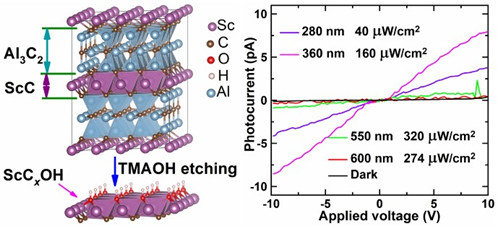Semiconductor type MXene two-dimensional transition metal carbide material synthesized by Ningbo Materials Institute
With the rise of flexible and transparent electronic technology, two-dimensional semiconductor materials have attracted much attention in recent years, especially the direct bandgap characteristics make these two-dimensional structures promising in the field of optoelectronics. In the past decade, researchers have successively developed typical two-dimensional semiconductor materials with direct band gaps such as MoS2 and phosphorene. However, the band gap of MoS2 is layer-dependent. The direct band gap can only be realized in a single-layer structure, and the chemical properties of phosphoene in the air environment are unstable. Therefore, in recent years, many studies have been devoted to optimizing these two-dimensional structures and exploring more two-dimensional semiconductor team members. Two-dimensional transition metal carbides (MXenes) are a class of two-dimensional materials newly developed since 2011. Their rich chemical element composition and tunable surface functional groups provide a broad space for the diversification of their properties. The MXenes material is mainly obtained by selectively etching Al atoms of the A layer of the three-dimensional layered MAX phase material, where M represents a pre-transition metal, A is mainly an element from Group 13-16, and X is C and / or N. MXenes material's rich chemical element composition and tunable properties make it show good application prospects in the fields of energy storage, electromagnetic interference shielding, composite materials, water purification and sensors. Generally speaking, these two-dimensional carbides exhibit intrinsic metallicity, and many of the group members are both electrically conductive and hydrophilic. With proper surface functional group Tx tuning, a few members such as Mo2CTx and Mo2TiC2Tx exhibit semiconductor-like transport properties, and theoretical work shows that they have an indirect band gap. Although theoretical work predicts that some members of MXenes have direct band gap semiconductor properties, they still face challenges in experimental synthesis. Therefore, further enriching the MXenes material system and introducing team members with direct bandgap semiconductor properties are of great significance to expand the MXenes material chemistry, structural diversity, and expand its potential applications in the field of optoelectronic devices.
The previous theoretical work of the Advanced Energy Materials Engineering Laboratory of the Ningbo Institute of Materials Technology and Engineering, Chinese Academy of Sciences showed that Sc2C is the only member of the MXenes system whose semiconductor properties do not depend on surface functional groups. In addition, hydroxyl-functionalized Sc2COH is predicted to Gap characteristics. However, it is difficult for the transition metal Sc to form a corresponding Al-containing MAX phase structure. Recently, the team of Linköping University in Sweden synthesized Sc-out-of-plane and in-plane chemically ordered i-MAX layered materials by introducing Sc into the ternary Mo-Al-C system, based on the selective etching method. Mo2ScC2Tx and Mo1.33CTx MXenes were obtained one after another, but selective etching of Al and Sc atoms occurred simultaneously in the solution containing fluoride. The above work shows that based on traditional ideas, it is very difficult to synthesize full Sc MXene by selectively etching the MAX phase in a corrosive fluorine-containing solution. Therefore, obtaining etchable precursors through structural design and establishing a mild and compatible etching chemistry are very important for obtaining full Sc MXene. The Advanced Energy Materials Engineering Laboratory used a new class of non-MAX phase layered materials as precursors, and introduced new paths in the MXenes system by etching new paths of Al (Si) -C sublayers in Zr3Al3C5 and Hf3 (AlSi) 4C6 Zr3C2Tx (Angewandte Chemie International Edition, 128 (16), 5092-5097) and Hf3C2Tx (ACS nano11 (4), 3841-3850) MXenes team members. On this basis, laboratory researchers synthesized ScAl3C3 precursors with a MAX-like structure, and selectively etched the Al-C sublayer in the ScAl3C3 phase in a relatively mild organic alkaline solution TMAOH to obtain a two-dimensional full scandium system. Carbide ScCxOH. It was confirmed by photoelectron spectroscopy, electron energy loss spectroscopy and transmission electron microscopy that the surface mainly contains -OH functional groups. In cooperation with the team of Professor Per Persson of Linköping University, Sweden, based on valence electron energy loss spectroscopy (VEELS) and cathode fluorescence spectroscopy (CL), the new Sc-based two-dimensional carbide has a direct band gap of about 2.5 eV. In cooperation with the team of Professor Liao Meiyong of the National Institute of Materials Science and Technology in Japan, a photodetector device was fabricated with a few layers of ScCxOH sheets in the peeled state, and it was found to have good photoelectric response in the ultraviolet and visible light region (0.125A / W, 10V, 360nm) High quantum efficiency (~ 43%), good transient response, no obvious trap effect. The response rate of this material is comparable to photodetectors made from two-dimensional materials such as graphene, low-layer MoS2, and GaSe, and is close to traditional GaN thin-film photodetectors (0.148 A W-1, 51%). The direct band gap semiconductor type ScCxOH material with moderate band gap value is expected to find application in the fields of visible light detectors and photocatalysis.
This work was recently published in the journal ACS Nano (DOI: 10.1021 / acsnano.8b06279). Related research has been supported by the National Natural Science Foundation of China, the National Key R & D Program, the Chinese Academy of Sciences 'Frontier Science Key Research Program, the Wang Kuancheng Education Fund, Purdue University's ITaP computing resources, and the Chinese Academy of Sciences' interdisciplinary innovation team.

Schematic diagram of the synthesis of ScCxOH and the photocurrent-voltage curve of the corresponding photodetector device
KOYO Needle Roller Bearings,KOYO roller bearing,KOYO thrust ball bearings,KOYO deep groove ball bearings,KOYO self-aligning ball bearing
Shanghai Yi Kai Cheng bearing Co., LTD , https://www.ykcbearing.com
